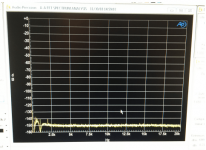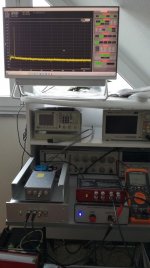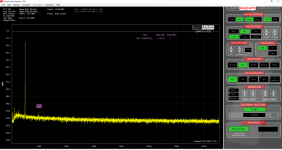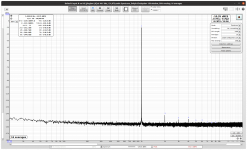Am I right? Viktors osc is approx. 10 dB better (-156 dBc).The measurement setup can be seen in the picture on the left. The device with the blue LED is the 1kHz oscillator. To the left of it the passiv twin T notch Filter (green LED). On the ground the R&S UPL Audio Analyzer. The Output of the oscillator is 2.5V RMS. The transfer function of the notch at 2 kHz is 0.3511 (--9.091dB). The gain of the post notch amplifier is 51 (34.151 dB). When you look at the FFT Output of the UPL you see the Fundamental at 1.00146 kHz with a level of 0.1591 V. The notch attentation of the Fundamental is about -58dB and with 34 dB amplification the result is 0.1591 V. The y-axis ist scaled in uV. At 2 kHz you can see a very small peak at about 2.5uV. To calculate the real level of the 2. Harmonic of the oscillator you must do the following calculation : 2.5uV/(0.3511*51) = 139.662 nV. The THD of the Oscillator is then : 20*log(139.662nV/2.5V) = -145.06 dB.
then post a correct test setup verified by a quality measuring device like AP or R&S. Nobody in the professional field trusts PC sound cards and subsequent software calculations. Especially not if you want to correctly measure a THD below -140dB. User KSTR #9493 has measuered Viktors oscillator with an AP SYS 2322. The THD was 10*log(10^(-144db/10) + 10^(-138db/10)) = -137.03dB. Very good value, but well over -140dB.Am I right? Viktors osc is approx. 10 dB better (-156 dBc).
It would perhaps be fairer to mention that :
"I've measured a Viktors 1Khz Oscillator built in 2012 (so, an early revision)"
A version from 10 years ago.
Best regards,
Patrick
"I've measured a Viktors 1Khz Oscillator built in 2012 (so, an early revision)"
A version from 10 years ago.
Best regards,
Patrick
You can send your Viktor osc to Amir (https://www.audiosciencereview.com/forum/index.php?reviews/). He makes measurements with his $30,000 AP, for free.
ok sorry. If there is a better version, I would be happy to see a measurement of a current version on an AP or R&S device or any other professional equipment. By the way, here is an AP SYS 2522 test of my first professional 1kHz oscillator built in 2018. THD is -140dB at 1,65V RMS . This is exactly the same value measured on my R&S Analyzer with passive Twin T Notch .It would perhaps be fairer to mention that :
"I've measured a Viktors 1Khz Oscillator built in 2012 (so, an early revision)"
A version from 10 years ago.
Best regards,
Patrick
Attachments
Jan Didden did a lot of measurements on the Viktor with his 2722, and his RTX :
https://www.diyaudio.com/community/threads/low-distortion-audio-range-oscillator.205304/post-6200298https://www.diyaudio.com/community/threads/low-distortion-audio-range-oscillator.205304/post-6206054
His Viktors are some 2 years old.
But I am sure he will tell you if there arre any updates.
Cheers,
Patrick
https://www.diyaudio.com/community/threads/low-distortion-audio-range-oscillator.205304/post-6200298https://www.diyaudio.com/community/threads/low-distortion-audio-range-oscillator.205304/post-6206054
His Viktors are some 2 years old.
But I am sure he will tell you if there arre any updates.
Cheers,
Patrick
The harmonics are below the noise. The bastards are hiding. ;-)Jan Didden did a lot of measurements on the Viktor with his 2722, and his RTX :
https://www.diyaudio.com/community/threads/low-distortion-audio-range-oscillator.205304/post-6200298https://www.diyaudio.com/community/threads/low-distortion-audio-range-oscillator.205304/post-6206054
His Viktors are some 2 years old.
But I am sure he will tell you if there arre any updates.
Cheers,
Patrick
Your math is corrrect, but I wonder why you're using such a short FFT (8k, if I'm interpreting the numbers on your screen photo correctly). Your harmonics are then very close to the noise floor, making the readout error prone.The measurement setup can be seen in the picture on the left. The device with the blue LED is the 1kHz oscillator. To the left of it the passiv twin T notch Filter (green LED). On the ground the R&S UPL Audio Analyzer. The Output of the oscillator is 2.5V RMS. The transfer function of the notch at 2 kHz is 0.3511 (--9.091dB). The gain of the post notch amplifier is 51 (34.151 dB). When you look at the FFT Output of the UPL you see the Fundamental at 1.00146 kHz with a level of 0.1591 V. The notch attentation of the Fundamental is about -58dB and with 34 dB amplification the result is 0.1591 V. The y-axis ist scaled in uV. At 2 kHz you can see a very small peak at about 2.5uV. To calculate the real level of the 2. Harmonic of the oscillator you must do the following calculation : 2.5uV/(0.3511*51) = 139.662 nV. The THD of the Oscillator is then : 20*log(139.662nV/2.5V) = -145.06 dB.
For illustration, a measurement of my oscillator at 2.5Vrms and analysed by a 256k FFT shows the 2nd harmonic at -109.6dBc (first attachment), whereas an 8k FFT shows no harmonics at all due to the noise floor having been shifted upwards by 15dB because of the lower FFT processing gain (second attachment).
As a matter of fact, I would expect still better performance numbers of your oscillator if you would use a longer FFT and more averaging.
Regards,
Braca
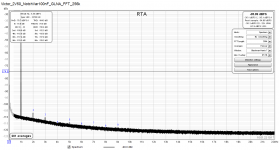

I think my Viktors are older than 2 years. And as far as I know, Viktor has made some changes to further lower harmonics after I got mine from him.
But, -148, -152, who cares! ;-)
Jan
But, -148, -152, who cares! ;-)
Jan
Hi,Your math is corrrect, but I wonder why you're using such a short FFT (8k, if I'm interpreting the numbers on your screen photo correctly). Your harmonics are then very close to the noise floor, making the readout error prone.
For illustration, a measurement of my oscillator at 2.5Vrms and analysed by a 256k FFT shows the 2nd harmonic at -109.6dBc (first attachment), whereas an 8k FFT shows no harmonics at all due to the noise floor having been shifted upwards by 15dB because of the lower FFT processing gain (second attachment).
As a matter of fact, I would expect still better performance numbers of your oscillator if you would use a longer FFT and more averaging.
Regards,
Braca
View attachment 1013646View attachment 1013647
the R&S UPL Audio Analyzer uses Zoom-FFT. Therefore I do not think that frequency components 2H 3H etc. are lost here. I also have a QA 401 and measured the same Oscillator with 32k FFT and 10 Avg with the same Notch. The output of the oscillator is 2.3634V (Agilent U1252B) . The FFT Plot of the QA 401 shows -112,10 dBV at 2kHz. These are 2.4831 uV. The real level of the 2H is then 2.4831uV/(0.3511*51) = 138.67 nV . THD is 20*log(138.67nv/2.3634V) = -144.63dB. Very close to the UPL measurment with -145.06 dB. Error about 0.3%. So you do not need expensive audio analyzers to verify the design of a good analog oscillator. My R&S UPL machine was built in 1996. But the perfomance of successor version UPV is not better in analog area.
Attachments
You can probably measure that with a $10 sound card. The magic happens in the notch filter and the post amp.
That was 1st generation Viktors. His latest ones are quite a bit better for a number of reasons. And I had a hard time to get the 2322 to measure this with some confidence which ist't that high (swap polarity and H2 still changes quite bit, change the attenuator a bit -- which already runs at way low output level to reduce fron-end distortion -- and the result also is not very stable).User KSTR #9493 has measuered Viktors oscillator with an AP SYS 2322. The THD was 10*log(10^(-144db/10) + 10^(-138db/10)) = -137.03dB. Very good value, but well over -140dB.
Then I'm this Mr. nobody ;-)Nobody in the professional field trusts PC sound cards and subsequent software calculations.
With a good sound card and a notch filter (which is the major unknown wrt distortion) and long FFT I'm getting more reliable results, even without a makeup amp (though I sometimes use a Tek AM502 for this). At -20dBFS the distortion of the RME ADI-2 Pro ADC is already negligible even without any notch. The 8k/16k FFT limit of my old AP is not SOTA and I sometimes use the monitor out to feed the RME and be able to use large FFT and better analysis capabilites (with REW).
Plus I can run the RME 100% galvanically isolated, its very portable, etc. If I had an APx555 that might be different (but even that machine has some drawbacks).
The biggest issue with my Viktors for me is the long warm-up time until the frequency is stable (as required for a long FFT to be meaningful), plus the rather high micro-instability from a set of 1/f noise phenomena. I haven't tried locking as of yet, but Jan's results are promising.
This! Anything that is <10...20dB down in the RMS noise floor (20...20k) of the DUT is irrelevant to me for any practical purposes.But, -148, -152, who cares! ;-)
There is a mod from Jan D., where you can attach a stable crystal source to stabilize the frequency. But I can't find the post at the moment.The biggest issue with my Viktors for me is the long warm-up time until the frequency is stable (as required for a long FFT to be meaningful), plus the rather high micro-instability from a set of 1/f noise phenomena. I haven't tried locking as of yet, but Jan's results are promising.
https://www.diyaudio.com/community/...range-oscillator.205304/page-445#post-6200395There is a mod from Jan D., where you can attach a stable crystal source to stabilize the frequency. But I can't find the post at the moment.
I am an electrical engineer and there is nothing magic in a noth filter and post amp. Maybe you have no idea about the transfer function of complex networks and the theory of nonlinear systems. But you can continue to measure up to -180dB with your 10 dollar sound cards.You can probably measure that with a $10 sound card. The magic happens in the notch filter and the post amp.
An earlier post from Vicnic. I trust his expertise.
Hello,
Yes. Harmonics of the 1kHz are difficult to measure. Often I see "nothing". Stable under -155dB via the passive notch.
Vic.
Hello,
Yes. Harmonics of the 1kHz are difficult to measure. Often I see "nothing". Stable under -155dB via the passive notch.
Vic.
better to use ES9038Q2M and tune its harmonics down to 10db lower than 4490. Or another way to get the THD+N lower than any APx555 is by adding an LPF 1kHz 2-4ord after ES9038Q2M(or 4490) to wipe out harmonics and noise.It is possible to get reasonable results without AP or low-distortion oscillators. DAC is AK4490 and ADC is AK5394.
I have also built a DAC board using ES9038Q2M and tuned the harmonics. My AK4490 board has almost as low harmonics as the ES9038Q2M but has much nicer harmonic profile. And -131dB H2 and lower higher harmonics is as good as I need. However I will upgrade my ADC to ES9822 when I get the chips.better to use ES9038Q2M and tune its harmonics down to 10db lower than 4490. Or another way to get the THD+N lower than any APx555 is by adding an LPF 1kHz 2-4ord after ES9038Q2M(or 4490) to wipe out harmonics and noise.
- Home
- Design & Build
- Equipment & Tools
- Low-distortion Audio-range Oscillator
